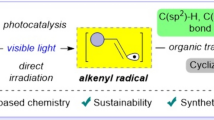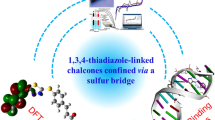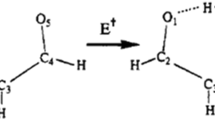Abstract
Photoinduced electron transfer in a series of naphthyl substituted phenanthrimidazoles has been studied in solutions. The intramolecular charge transfer (CT) leads to a large Stokes shift and large dipole moment in the fluorescent state. Solvatochromic effects on the spectral position and profile of the stationary fluorescence spectra clearly indicate the CT character of the emitting singlet states of all the compounds studied. An analysis of the CT fluorescence lead to the quantities relevant for the electron transfer in the Marcus inverted region.





Similar content being viewed by others
References
Hush NS (1985) Distance dependence of electron transfer rates. Coord Chem Rev 64:135–157
Marcus RA (1989) Relation between charge transfer absorption and fluorescence spectra and the inverted region. J Phys Chem 93:3078–3086
Gould IR, Young RH, Moody RE, Farid S (1991) Contact and solvent-separated geminate radical ion pairs in electron-transfer photochemistry. J Phys Chem 95:2068–2080
Gould IR, Noukakis D, Gomez-Jahn L, Young RH, Goodman JL, Farid S (1993) Radiative and nonradiative electron transfer in contact radical-Ion pairs. J Chem Phys 176:439–456
Cortes J, Heitele H, Jortner J (1994) Band shape analysis of the charge transfer fluorescence in barrelene based electron-donor-acceptor compounds. J Phys Chem 98:2527–2536
Mulliken RS, Person WB (1969) Molecular complexes: a lecture and reprint volume. Weinheim, VCH
Murrell JN (1959) Molecular complexes and their spectra. IX the relationship between the stability of a complex and the intensity of its charge-transfer bands. J Am Chem Soc 81:5037–5043
Bixon M, Jortner J, Verhoeven JW (1994) Lifetimes for radiative charge recombination in donor-acceptor molecules. J Am Chem Soc 116:7349–7355
Herbich J, Kapturkiewicz A (1998) Electronic structure and molecular conformation in the excited charge transfer singlet states of p-acridyl and other aryl derivatives of aromatic amines. J Am Chem Soc 120:1014–1029
Kapturkiewicz A, Herbich J, Karpiuk J, Nowacki J (1997) Intramolecular radiative and radiationless charge recombinations in donor-acceptor carbazole derivatives. J Phys Chem A 101:2332–2344
Kapturkiewicz A, Nowacki J (1999) Properties of the intramolecular excited charge-transfer states of carbazol-9-yl derivatives of aromatic ketones. J Phys Chem A 103:8145–8155
Borowicz P, Herbich J, Kapturkiewicz A, Nowacki J (1999) Excited charge-transfer states in donor-acceptor indole derivatives. Chem Phys 244:251–261
Borowicz P, Herbich J, Kapturkiewicz A, Nowacki J, Opallo M (1999) Radiative and nonradiative electron transfer in donor-acceptor phenoxazine and phenothiazine derivatives. Chem Phys 249:49–62
Grabowski ZR, Rotkiewicz K, Siemiarczuk A, Cow-ley DJ, Baumann W (1979) Nouv. Twisted intramolecular charge transfer states (TICT). A new class of excited states with a full charge separation. J Chim 3:443–454
Masaki S, Okada T, Mataga N, Sakata Y, Misumi S (1976) On the solvent-induced changes of electronic structures of intramolecular exciplexes. Bull Chem Soc Jpn 49:1277–1283
Richard JP, Amyes TL (2001) Proton transfer at carbon. Curr Opin Chem Biol 5:626–633
Stoner Ma D, Jaye AA, Ronayne KL, Nappa J, Meech SR, Tonge PJ (2008) An Alternate proton acceptor for excited state protein transfer in green fluorescent protein: rewiring GFP. J Am Chem Soc 130:1227–1235
Paterson MJ, Robb MA, Blancafort L, DeBellis AD (2005) Mechanism of an exceptional class of photostabilizers: a seam of conical intersection parallel to excited state intramolecular proton transfer (ESIPT) in o-hydroxyphenyl-(1,3,5)-triazine. J Phys Chem A 109:7527–7537
Lim SJ, Seo J, Park SY (2006) Photochromic switching of excited-state intramolecular proton-transfer (ESIPT) fluorescence: a unique route to high-contrast memory switching and nondestructive readout. J Am Chem Soc 128:14542–14547
Klymchenko AS, Shvadchak VV, Yuschenko DA, Jain N, Mély Y (2008) Excited-state intramolecular proton transfer distinguishes microenvironments in single- and double-stranded DNA. J Phys Chem B 112:12050–12055
Kwon JE, Park SY (2011) Advanced Organic optoelectronic materials: harnessing excited-state intramolecular proton transfer (ESIPT) process. Adv Mater 23:3615–3642
Dogonadze RR, Kuznetsov AM, Marsagishvili TA (1980) The present state of the theory of charge transfer in condensed phase. Electrochim Acta 25:1–28
Mataga N, Kaifu Y, Koizumi M (1955) The solvent effect on fluorescence spectrum. Change of solute-solvent interaction during the lifetime of excited solute molecule. Bull Chem Soc Jpn 28:690
Frisch MJ, Trucks GW, Schlegel HB, Scuseria GE, Robb MA, Cheeseman JR, Montgomery JA Jr, Vreven T, Kudin KN, Burant JC, Millam JM, Iyengar SS, Tomasi J, Barone V, Mennucci B, Cossi M, Scalmani G, Rega N, Petersson GA, Nakatsuji H, Hada M, Ehara M, Toyota K, Fukuda R, Hasegawa J, Ishida M, Nakajima T, Honda Y, Kitao O, Nakai H, Klene M, Li X, Knox JE, Hratchian HP, Cross JB, Bakken V, Adamo C, Jaramillo J, Gomperts R, Stratmann RE, Yazyev O, Austin AJ, Cammi R, Pomelli C, Ochterski JW, Ayala PY, Morokuma K, Voth GA, Salvador P, Dannenberg JJ, Zakrzewski VG, Dapprich S, Daniels AD, Strain MC, Farkas O, Malick DK, Rabuck AD, Raghavachari K, Foresman JB, Ortiz JV, Cui Q, Baboul AG, Clifford S, Cioslowski J, Stefanov BB, Liu G, Liashenko A, Piskorz P, Komaromi I, Martin RL, Fox DJ, Keith T, Al-Laham MA, Peng CY, Nanayakkara A, Challacombe M, Gill PMW, Johnson B, Chen W, Wong MW, Gonzalez C, Pople JA (2004) Gaussian 03 (Revision E.01). Gaussian, Inc, Wallingford
Chiba K, Aihara JI, Araya K, Matsunaga Y (1980) The Electronic spectra of intramolecular charge-transfer compounds and their marked solvatochromism in a strong hydrogen-bonding solvent: 2-(arylmethylene)-1,3-indandiones and 2-(1-naphthyl)-p-benzoquinone. Bull Chem Soc Jpn 53:1703–1708
McGlynn SP, Azumi T, Kinoshita M (1969) Molecular spectroscopy of the triplet state. Prentice Hall, Englewood Cliffs
Willard DM, Riter RE, Levinger NE (1998) Dynamics of polar solvation in lecithin/water/cyclohexane reverse micelles. J Am Chem Soc 120:4151–4160
Bottcher CJF, Van Belle OC, Bordewijk P, Rip A (1973) In theory of electronic polarization, Eeds. Elsevier, Amsterdam, Vol. I
Czerwieniec R, Herbich J, Kapturkiewicz A, Nowacki J (2000) Radiative electron transfer in planar donor–acceptor quinoxaline derivatives. Chem Phys Lett 325:589–598
Jayabharathi J, Thanikachalam V, Sathishkumar R (2014) Excited charge transfer states in donor–acceptor fluorescent phenanthroimidazole derivatives. J Fluoresc 24:431–444
Liptay W, Lim EC (1974) Polarizabilities of molecules in excited electronic state. In: In Excited States, Ed. Academic, New York, p 129
Rettig W, Zander M (1982) On Twisted intramolecular charge transfer (TICT) stated in N-aryl-carbazoles. Chem Phys Lett 87:229–234
Onsager L (1936) Electric moments of molecules in liquids. J Am Chem Soc 58:1486–1493
Bo¨ttcher CJF, Van Belle OC, Bordewijk P, Rip A (1973) In Theory of electric polarization, Eds. Elsevier, Amsterdam, Vol. I
Lippert EZ (1955) Dipolmoment and Elektronenstruktur von angeregten Molekülen. Naturforsch 10:541–545
Mataga N, Kaifu Y, Koizumi M (1956) On the base strength of some nitrogen heterocycles in the excited state. Bull Chem Soc Jpn 29:373–379
McRae EG (1957) Theory of solvent effects on molecular electronic spectra. Frequency shifts. J Phys Chem 61:562–572
Marcus RA (1963) Free Energy of nonequilibrium polarization systems. II. Homogeneous and electrode systems. J Chem Phys 38:1858
Castellan GW (1985) Physical chemistry, 3rd edn. Narosa Publishing House, Delhi
N.J. Turro, V. Ramamurthy and J.C. Scaiano, (2009), Principles of Molecular Photochemistry: An introduction, University Science books
Kapturkiewicz A (1992) Electrochemical generation of excited TICT states. V. Evidence of inverted Marcus region. J Chem Phys 166:259
Mulliken RS (1952) Molecular compounds and their spectra. J Am Chem Soc 74:811–824
Acknowledgments
One of the authors Prof. J. Jayabharathi is thankful to DST [No. SR/S1/IC-73/2010], DRDO (NRB-213/MAT/10-11), UGC (F. No. 36-21/2008 (SR)) and CSIR (NO 3732/NS-EMRII) for providing funds to this research study.
Author information
Authors and Affiliations
Corresponding author
Rights and permissions
About this article
Cite this article
Jayabharathi, J., Thanikachalam, V., Ramanathan, P. et al. Radiative and Nonradioactive Electron Transfer in Donor–Acceptor Phenanthrimidazoles. J Fluoresc 24, 1603–1611 (2014). https://doi.org/10.1007/s10895-014-1446-4
Received:
Accepted:
Published:
Issue Date:
DOI: https://doi.org/10.1007/s10895-014-1446-4




